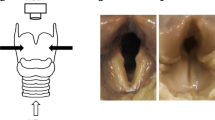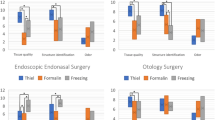Abstract
Whole-organ sectioning is an important technique for the assessment of laryngeal pathology. Since currently established methods require prior decalcification which causes morphological changes, the critical border area between cartilage and surrounding soft tissue cannot be investigated in the same specimen and morphometric studies are not possible. Plastination is a laboratory technique that has previously demonstrated its capacity to overcome these shortcomings. In so doing water and lipids are replaced by curable polymer within the laryngeal cells making decalcification unnecessary. In the present study, more than 50 human larynges were processed using block plastination (BP) and sheet plastination (SP). For BP the complete organ was plastinated as a whole and then cut into thin serial sections. For SP the fresh organ was sliced first and plastinated in a second step. Findings demonstrated that SP allowed for the production of whole-organ sections within a period of 1 week only. Section thicknesses were as thin as 15 mm using a diamond wire saw and an ultramilling device. Sectioning was possible in both coronary and horizontal planes. Following BP, specimens were cut in an industrial cutting machine to thicknesses of about 0.6 mm. Shrinkage of tissue was less than 10% for both methods. In all, SP was technically superior to routine paraffin histology, although cutting equipment is very expensive and delicate in handling. At present the technique of BP is the method of choice for macromorphometrical investigations on serial sections of the human larynx.
Similar content being viewed by others
References
Eckel HE, Sittel C (1995) Morphometry of the larynx in horizontal sections. Am J Otolaryngol 16: 40–48
Eckel HE, Sittel C, Walger M, Sprinzl GM, Koebke J (1993) Plastination: a new approach to morphological research and instruction with excised larynges. Ann Otol Rhinol Laryngol 102:660–665
Eckel HE, Sittel C, Zorowka P, Jerke A (1993) Dimensions of the laryngeal framework in adults. Surg Radiol Anat 16: 31–36
Ekem JK (1972) Improved histological technique for the study of laryngeal carcinoma. Can J Med Technol 34: 228–234
Friedrich G, Kainz J (1988) Morphometrie des Kehlkopfes an Horizontalschnitten. Basisdaten für die quantitative Auswertung moderner bildgebender Verfahren. Laryngorhinootologie 67:269–274
Glanz H (1984) Carcinoma of the larynx. Growth, p-classification and grading of squamous cell carcinoma of the vocal cords. Adv Otorhinolaryngol 32: 1–123
Hagens G von (1979) Impregnation of soft biological specimens with thermosetting resins and elastomers. Anat Rec 194: 247–255
Hagens G von, Tiedemann K, Kriz W (1987) The current potential of plastination. Anat Embryol 175: 411–421
Harrison DFN (1976) A long-term comparative study of the mammalian larynx, based on whole organ serial sectioning. Acta Otolaryngol (Stockte) 81: 167–172
Kirchner JA (1969) One hundred laryngeal cancers studied by serial section. Ann Otol Rhinol Laryngol 78: 689–709
Kirchner JA (1975) Staging as seen in serial sections. Laryngoscope 85: 1816–1821
Kirchner JA (1989) What have whole organ sections contributed to the treatment of laryngeal cancer? Ann Otol Rhinol Laryngol 989: 661–667
Kleinsasser O (1992) Revision of classification of laryngeal cancer, is it long overdue? Proposals for an improved TN-classification. J Laryngol Otol 106: 197–204
Meyer-Breiting E, Burkhardt A (1988) Tumours of the larynx. Springer, Berlin Heidelberg New York
Michaels L, Gregor LT (1980) Examination of the larynx in the histopathology laboratory. J Clin Pathol 33: 705–710
Reidenbach MM, Schmidt HM (1994) Anatomical considerations on arytenoid cartilage dislocation. Clin Anat 7: 324–330
Romeis B (1989) Mikroskopische Technik, 17th edn. Urban & Schwarzenberg, Munich
Seibold R, Eitel F, Waldner H, Brunner U, Hagens G von (1991) Neuartige Anwendung der Plastination in der Knochenhistologie. Unfallchirurg 94: 624–633
Shapshay SM, Hybels RL, Bohigian RK (1990) Laser excision of early vocal cord carcinoma: indications, limitations, and precautions. Ann Otol Rhinol Laryngol 99: 46–50
Sprinzl GM, Eckel HE, Sittel C, Thumfart WF, Koebke J (1995) Ganzorganplastination in der Hals-Nasen-Ohrenheilkunde. HNO 43: 282–286
Tucker GF (1961) A histological method for the study of the spread of carcinoma within the larynx. Ann Otol Rhinol Laryngol 70: 910–921
Author information
Authors and Affiliations
Rights and permissions
About this article
Cite this article
Sittel, C., Eckel, H.E., Sprinzl, G.M. et al. Plastination of the larynx for whole-organ sectioning. Eur Arch Otorhinolaryngol 254 (Suppl 1), S93–S96 (1997). https://doi.org/10.1007/BF02439734
Issue Date:
DOI: https://doi.org/10.1007/BF02439734




